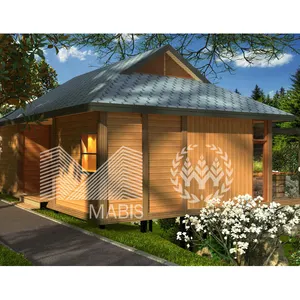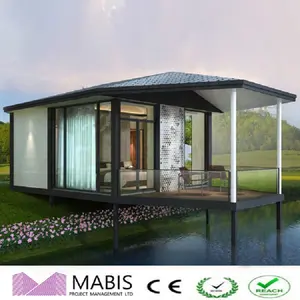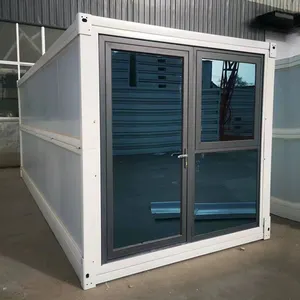(479 products available)








































































































































































































































Florida tiny houses come in different types, each with unique designs and purposes. Here are the most common types of tiny houses in Florida:
Mobile tiny houses
Mobile tiny houses are also known as tiny house on wheels (THOW). As the name suggests, these houses are built on trailers, just like campers. They are similar to traditional tiny houses regarding design and space optimization. Nonetheless, mobile tiny houses incorporate wheels in their construction, making them portable.
Mobile tiny houses are popular among tiny house enthusiasts who value mobility and flexibility. Since they are built on trailers, these houses can be moved from one place to another. As such, they allow homeowners to change their locations frequently. Mobility also means that owners can move their tiny houses to different locations for rent, increasing the rental property's value. Additionally, mobile tiny houses are an excellent option for people who love traveling and exploring new places.
Modular tiny houses
Modular tiny houses are also known as prefabricated or modular houses. These houses are constructed in sections (modules) in a factory, then transported to the site for assembly. These houses offer the same benefits as traditional tiny houses, including affordability, eco-friendliness, and efficient use of space.
Modular tiny houses are versatile since they come in different designs, sizes, and layouts. They can be placed linearly or stacked on top of each other to create multiple units. Additionally, since they are constructed in a controlled environment, they are not exposed to weather elements that could damage them. This ensures consistent quality and minimizes construction time.
Container houses
Container houses are tiny homes built using shipping containers. Shipping containers are used to transport goods and are designed to withstand harsh weather conditions. As such, these houses are durable and weather-resistant. Container houses are also affordable, depending on the size of the container used. For instance, a 20-foot container is cheaper than a 40-foot container.
Shipping containers are readily available, making them accessible. This is because many people import and export goods using shipping containers. As such, one can easily find a shipping container when they need to build a tiny house. Container houses are also versatile, as they can be stacked and combined to create different sizes and designs.
When it comes to features and functions, Florida tiny houses are designed to maximize space, improve energy efficiency, and offer a minimalist lifestyle. Here are some key features alongside their functions:
Space-Saving Furniture
Space-saving furniture includes pull-out beds, wall-mounted tables, and storage ottomans. These multifunctional furniture pieces create a living room that can be converted into a bedroom at night. During the day, the wall-mounted table can be used to eat breakfast, and it can be folded to free up space in the house. Space-saving furniture helps maximize limited floor space while offering several functions.
Lofted Areas
Florida tiny houses have lofted areas, which are elevated platforms. These include lofted ceilings, hidden nooks, and raised floors. With a lofted area, tiny houses give the illusion of a spacious room with high ceilings. Lofted areas utilize vertical space, creating additional storage space where items can be stored without occupying floor space. These lofted areas also create a separate sleeping space and improve air circulation in the tiny house.
Energy-Efficient Appliances
Energy-efficient appliances are designed to use less energy than standard ones. They include dishwashers, refrigerators, and washing machines. Energy-efficient appliances help reduce the overall energy consumption of the tiny house. This, in turn, lowers utility bills, making the house more affordable. Additionally, these appliances are environmentally friendly, which helps reduce one’s carbon footprint.
Built-In Storage
Storage can be built under the bed, within the stairs, or in seating areas. Built-in storage makes tiny homes more organized as it reduces clutter and disorganization. It creates a clean and tidy look that is appealing. Additionally, with built-in storage, homeowners can find items easily, thus saving time.
Outdoor Living Spaces
Outdoor living spaces include porches, decks, and landscaped areas. They create a feeling of spaciousness away from the confines of indoor spaces. Outdoor spaces are relaxing and offer a serene environment where one can unwind and destress. In addition, they reduce the stress of maintaining tiny indoor spaces, as most outdoor areas are low-maintenance.
Florida tiny houses are perfectly designed to maximize the limited space. They have become a popular option for many people because of their affordability, eco-friendliness, and mobility. Tiny houses can be used for different purposes. Below are some applications of tiny houses.
Primary Residences
Florida tiny houses are an excellent choice for individuals or families looking for affordable housing options. They are cheaper than traditional homes, making them accessible to people with different income levels. Additionally, tiny houses require fewer materials to build, which reduces the overall cost. Moreover, tiny houses are designed to maximize space and provide essential amenities for comfortable living. Tiny houses are also environmentally friendly due to their smaller footprints, which consume less energy.
Vacation Homes
Vacation tiny houses are located in serene environments that promote relaxation and tranquility. They are designed with a focus on sustainability, using eco-friendly materials and energy-efficient appliances. Additionally, they promote a minimalist lifestyle, encouraging individuals to disconnect from the hustle and bustle of everyday life and enjoy nature.
These houses are also highly customizable, allowing homeowners to create spaces that meet their unique needs and preferences. For instance, some may have a deck overlooking a beautiful landscape, while others may have an outdoor shower or a fire pit area.
Guest Houses
Florida guest house tiny houses are an excellent option for homeowners looking to accommodate guests without compromising their living space. They occupy a small footprint, thus maximizing the available space. Additionally, they are self-contained, providing guests with privacy and independence. Tiny houses on guest spaces are also highly versatile and can be relocated if necessary.
Moreover, they promote a minimalist lifestyle, encouraging guests to embrace simplicity and reduce their consumption.
Home Offices
With the rise of remote work, tiny houses have become popular as home offices. They offer a quiet and distraction-free environment to work efficiently and productively. Home offices are designed to provide the necessary amenities, such as a comfortable workspace, storage solutions, and internet connectivity. Additionally, they are separate from the main house, thus reducing distractions and interruptions.
Workshops and Studios
Florida tiny houses can be transformed into workshops or studios. This is because they have open floor plans that can be customized to fit different uses. They are also designed to maximize space with built-in storage solutions and efficient layouts. Tiny houses are also portable, thus offering the option of relocating the space when necessary.
Rental Properties
Additionally, Florida tiny houses make for excellent rental properties. Their affordability allows homeowners to purchase them and rent them out for extra income. They are also attractive to prospective renters due to their unique design and eco-friendliness. Renting a tiny house is cheaper than renting an apartment or a larger house, making it an attractive option for many people.
When purchasing a tiny house, there are several factors that should be considered to ensure one gets a product that is in line with their needs and preferences. Below are some of them.
Consider the Location
Where the tiny house will be located has an impact on the design and all other factors. Therefore, it is important to first consider the location before anything else. If the tiny house is to be located in a place with a harsh climate, then it is important to choose a design that will be able to withstand such weather conditions. For example, harsh climates with extreme heat require houses with proper insulation and ventilation, while extreme cold requires houses with strong and durable structure.
The Purpose of the House
The purpose of the tiny house plays a big role in its design and features. For instance, if the tiny house is meant to be used as a mobile home, then it is important to consider the right features such as lightweight materials, a durable chassis, and reliable towing options. On the other hand, if the purpose of the tiny house is to be rented out, then it is important to ensure that it has appealing features such as a comfortable layout, stylish interior design, and all necessary amenities.
The Budget
Budget is a crucial factor when it comes to choosing tiny houses for sale in Florida. It is important to choose a tiny house that one can comfortably afford without straining. One can find a good tiny house that fits their budget by shopping around and comparing different prices and features. This will ensure that one does not settle for a house just because it is affordable, but instead get one that is within their budget and also meets their needs.
Quality of Materials and Workmanship
It is important to choose a tiny house that has quality materials and craftsmanship. This is because quality means longevity, and as such, a tiny house with quality materials will definitely last longer. Inspections go a long way in ensuring that everything is working properly and meeting one’s expectations.
Q1. What is the benefit of a pre-owned Florida tiny house over a new one?
A1. Pre-owned Florida tiny houses often have the benefit of being settled in already, with any known issues resolved. They may also be less expensive than a new build, allowing for potential renovations or customizations.
Q2. What are some essential features to include in a Florida tiny house?
A2. Essential features to include are space-maximizing furniture, a fully equipped kitchen, a functional bathroom, a comfortable sleeping area, and ample storage solutions. Considerations for sustainability, such as solar panels and energy-efficient appliances, are also important.
Q3. How can one effectively market a tiny house?
A3. Effectively market a tiny house by emphasizing its unique selling points, such as affordability, eco-friendliness, and minimalist lifestyle promotion. Utilize social media platforms, create a visually appealing website, and engage in tiny house communities. Consider offering workshops or tours to attract potential buyers.
Q4. Are there financing options available for purchasing a tiny house?
A4. Financing options for tiny houses vary. Some banks offer personal loans or mortgage options for tiny houses on foundations. If the tiny house is considered an RV, financing may come from specialized RV lenders. It’s important to research and find the best financing option that suits the tiny house setup.
Q5. What is the average cost of building a tiny house in Florida?
A5. The average cost can vary significantly depending on design, materials, and whether it is self-built or professionally constructed. On average, a tiny house can cost anywhere from $20,000 to $60,000 or more for high-end finishes and custom designs. Understanding the cost breakdown is essential for effective budgeting.